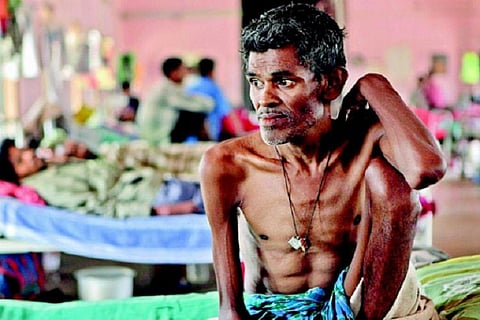

On September 14, the United Nations took up a resolution to eradicate tuberculosis around the world by the year 2030. A 53-point declaration put together by leaders present at the summit has stated that the leaders would come together to end the epidemic and raise 13 billion dollars annually to fight tuberculosis.
However, given India’s large population and the high prevalence rates of multidrug resistant tuberculosis in the country, many seem sceptical about how such a goal would be met.
“Back in 2012 when I was a postgraduate student, we’d have seen maybe one case of multidrug resistance per hundred patients, but today I see maybe one in every twenty cases,” says Dr Roshan a Consultant Pulmonologist from Chennai, “In fact this morning alone I saw two patients who presented with multidrug resistant tuberculosis.”
Earlier in March, Prime Minister Narendra Modi had announced that India would work to eliminate and eradicate tuberculosis by the year 2025. However, as several experts pointed out at the time, access to appropriate medications, particularly for those suffering from multidrug resistant tuberculosis, was proving to be a hindrance for those who require the medications.
“Officially speaking, anytime a case of multidrug resistant tuberculosis is found, it must be reported to the central government and the person has to start taking treatment from a government healthcare centre,” explains Dr Roshan, “In practice, it may vary slightly.”
Dr Roshan is among many who strongly feel that low patient compliance along with alternate day therapy, particularly DOTS, has resulted in a spike in the number of drug resistant TB. DOTS, is the acronym for Directly Observed Therapy Short-course, which is an initiative by which people diagnosed with TB are given medication for 6 months. Through this effort a healthcare worker administers and watches as an individual takes the medication, to ensure that the complete course of antibiotics is taken. However, some experts, including Dr Roshan, feel that the alternating days on which drugs are given through DOTS may have in fact aggravated the onset of multidrug resistant tuberculosis.
“DOTS has been around for around 20 years, if we are still struggling to control this disease, clearly it is not working somewhere,” a general physician TNM spoke to said, “Over the past few years, we are seeing an increase in the rates of strains of TB which don’t respond to traditional medications usually given. I strongly believe that we need a different approach, DOTS may have worked in the beginning, but we have different strains and ones resistant to multiple drugs now. These methods won’t work,” he stated.
In August, the Telangana government had acquired the drug bedaquiline, a last option often given to patients who are suffering from multidrug resistant TB, but despite India reporting such high numbers of multidrug resistant TB, access to these drugs has been made difficult.
“Bedaquiline and other drugs aren’t enough in practice, in theory these may seem like the only options to turn to, but in practice there are combinations of other drugs which are utilised. Instead of relying on methods such as DOTS, it might be time that we considered options which were conceived based on studies done here in India, something tailored to our population,” Dr Roshan says.
In 2016 alone, of the 2.79 million cases of TB reported in India, 10% were found to be resistant to standardly utilized drugs.
While lack of access to end-line drugs, such as bedaquiline and delamanid, are one part of the problem, there are other issues to be addressed as well, according to Hyderabad based physician Dr Arvind.
“It’s not just about procuring the drugs, but we have to come up with a more effective method than DOTS. We need to keep proper track of all those who do get diagnosed with a resistant form of TB and come up with a means to better treat them,” states Dr Arvind, “DOTS was effective to some extent, but the prevalence of resistance now calls for different methods to be implemented. Unless we figure out how to best do so, bringing down TB rates will be difficult.”